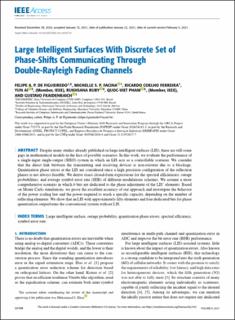| dc.contributor.author | Figueiredo, Felipe A. P. De | |
| dc.contributor.author | Facina, Michelle S. P. | |
| dc.contributor.author | Ferreira, Ricardo C. | |
| dc.contributor.author | Ai, Yun | |
| dc.contributor.author | Ruby, Rukhsana | |
| dc.contributor.author | Pham, Quoc-Viet | |
| dc.contributor.author | Fraidenraich, Gustavo | |
| dc.date.accessioned | 2021-03-10T11:43:19Z | |
| dc.date.available | 2021-03-10T11:43:19Z | |
| dc.date.created | 2021-01-24T23:48:24Z | |
| dc.date.issued | 2021 | |
| dc.identifier.citation | IEEE Access. 2021, . | en_US |
| dc.identifier.issn | 2169-3536 | |
| dc.identifier.uri | https://hdl.handle.net/11250/2732598 | |
| dc.description.abstract | Despite many studies already published on large intelligent surfaces (LIS), there are still some gaps in mathematical models in the face of possible scenarios. In this work, we evaluate the performance of a single-input single-output (SISO) system in which an LIS acts as a controllable scatterer. We consider that the direct link between the transmitting and receiving devices is non-existent due to a blockage. Quantization phase errors at the LIS are considered since a high precision configuration of the reflection phases is not always feasible. We derive exact closed-form expressions for the spectral efficiencies, outage probabilities, and average symbol error rate (SER) of different modulations schemes. We assume a more comprehensive scenario in which b bits are dedicated to the phase adjustment of the LIS’ elements. Based on Monte Carlo simulations, we prove the excellent accuracy of our approach and investigate the behavior of the power scaling law and the power required to reach a specific capacity, depending on the number of reflecting elements. We show that an LIS with approximately fifty elements and four dedicated bits for phase quantization outperforms the conventional system without LIS. | en_US |
| dc.language.iso | eng | en_US |
| dc.publisher | Institute of Electrical and Electronics Engineers (IEEE) | en_US |
| dc.relation.uri | https://ieeexplore.ieee.org/stamp/stamp.jsp?tp=&arnumber=9333565 | |
| dc.title | Large Intelligent Surfaces With Discrete Set of Phase-Shifts Communicating Through Double-Rayleigh Fading Channels | en_US |
| dc.type | Peer reviewed | en_US |
| dc.type | Journal article | en_US |
| dc.description.version | acceptedVersion | en_US |
| dc.source.pagenumber | 20 | en_US |
| dc.source.journal | IEEE Access | en_US |
| dc.identifier.doi | 10.1109/ACCESS.2021.3053773 | |
| dc.identifier.cristin | 1878010 | |
| dc.description.localcode | © 2020 IEEE. Personal use of this material is permitted. Permission from IEEE must be obtained for all other uses, in any current or future media, including reprinting/republishing this material for advertising or promotional purposes, creating new collective works, for resale or redistribution to servers or lists, or reuse of any copyrighted component of this work in other works. | en_US |
| cristin.ispublished | true | |
| cristin.fulltext | postprint | |
| cristin.qualitycode | 1 | |
